Strategies for Enhancing Performance, Culture, and Employee Engagement
VerifiedAdded on 2023/01/19
|9
|2120
|46
Report
AI Summary
This report provides a comprehensive analysis of Tata Group's management strategies, focusing on performance initiatives, organizational culture, and employee engagement. It explores the use of the work-life balance method and MBO for performance improvement. The report also examines leadership styles, including transformational leadership, and their impact on organizational culture. Additionally, it delves into strategies for enhancing employee engagement, such as recognition programs and motivational theories. The report concludes with recommendations for strategies related to organizational performance, cultural improvement, and employee engagement, emphasizing the importance of these elements in achieving organizational goals. The report references various academic sources to support its findings and recommendations.
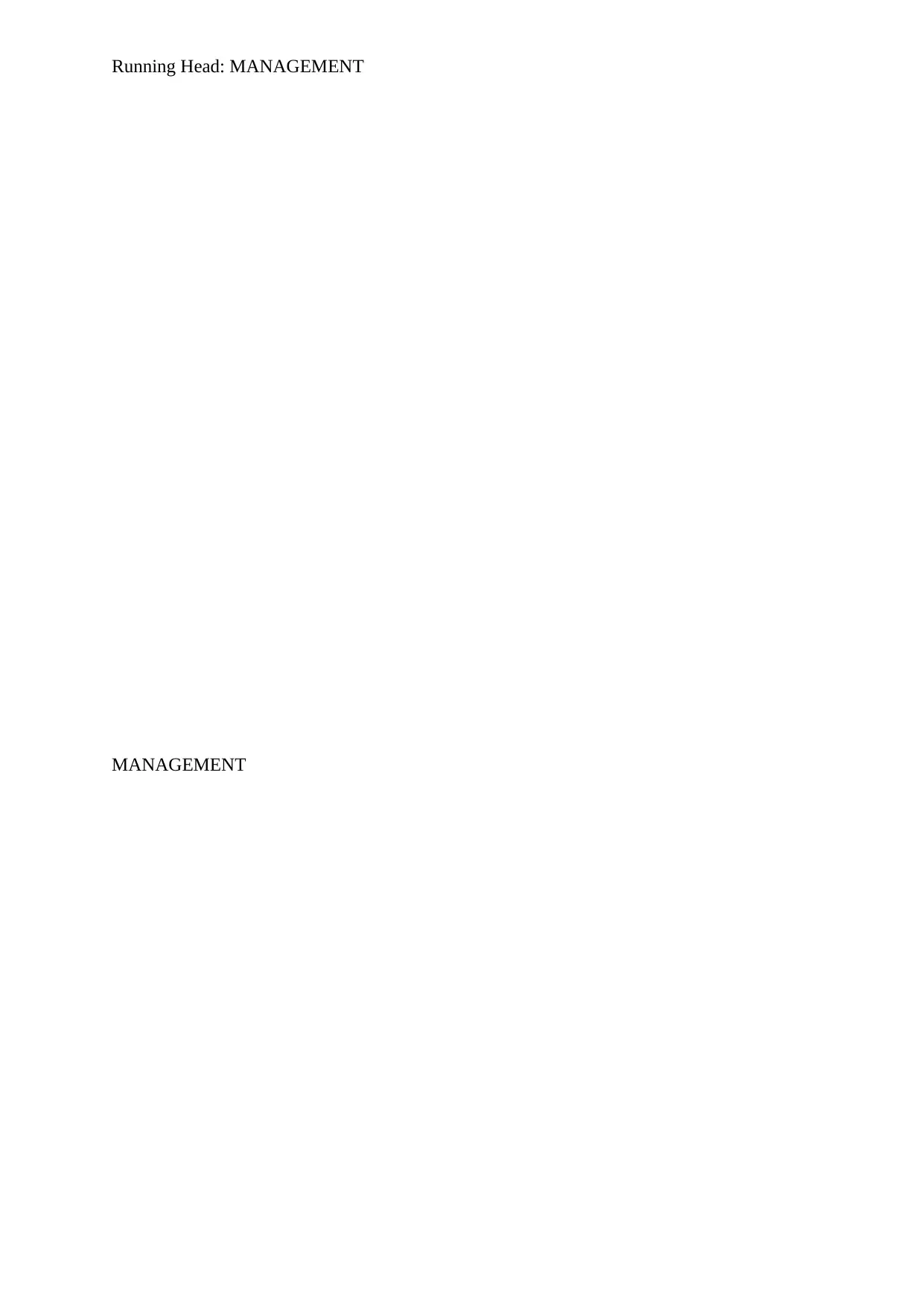
Running Head: MANAGEMENT
MANAGEMENT
MANAGEMENT
Paraphrase This Document
Need a fresh take? Get an instant paraphrase of this document with our AI Paraphraser
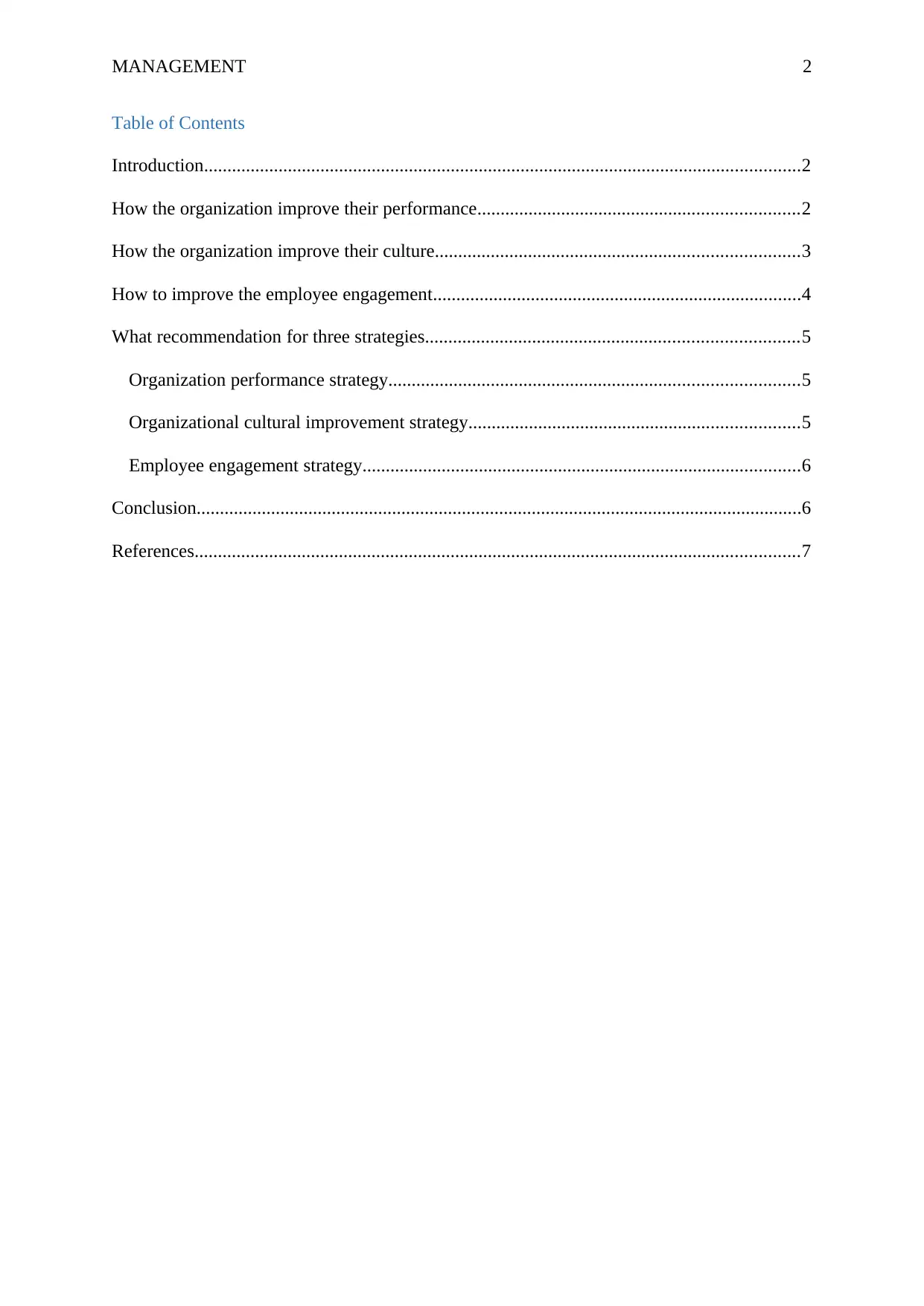
MANAGEMENT 2
Table of Contents
Introduction................................................................................................................................2
How the organization improve their performance.....................................................................2
How the organization improve their culture..............................................................................3
How to improve the employee engagement...............................................................................4
What recommendation for three strategies................................................................................5
Organization performance strategy........................................................................................5
Organizational cultural improvement strategy.......................................................................5
Employee engagement strategy..............................................................................................6
Conclusion..................................................................................................................................6
References..................................................................................................................................7
Table of Contents
Introduction................................................................................................................................2
How the organization improve their performance.....................................................................2
How the organization improve their culture..............................................................................3
How to improve the employee engagement...............................................................................4
What recommendation for three strategies................................................................................5
Organization performance strategy........................................................................................5
Organizational cultural improvement strategy.......................................................................5
Employee engagement strategy..............................................................................................6
Conclusion..................................................................................................................................6
References..................................................................................................................................7
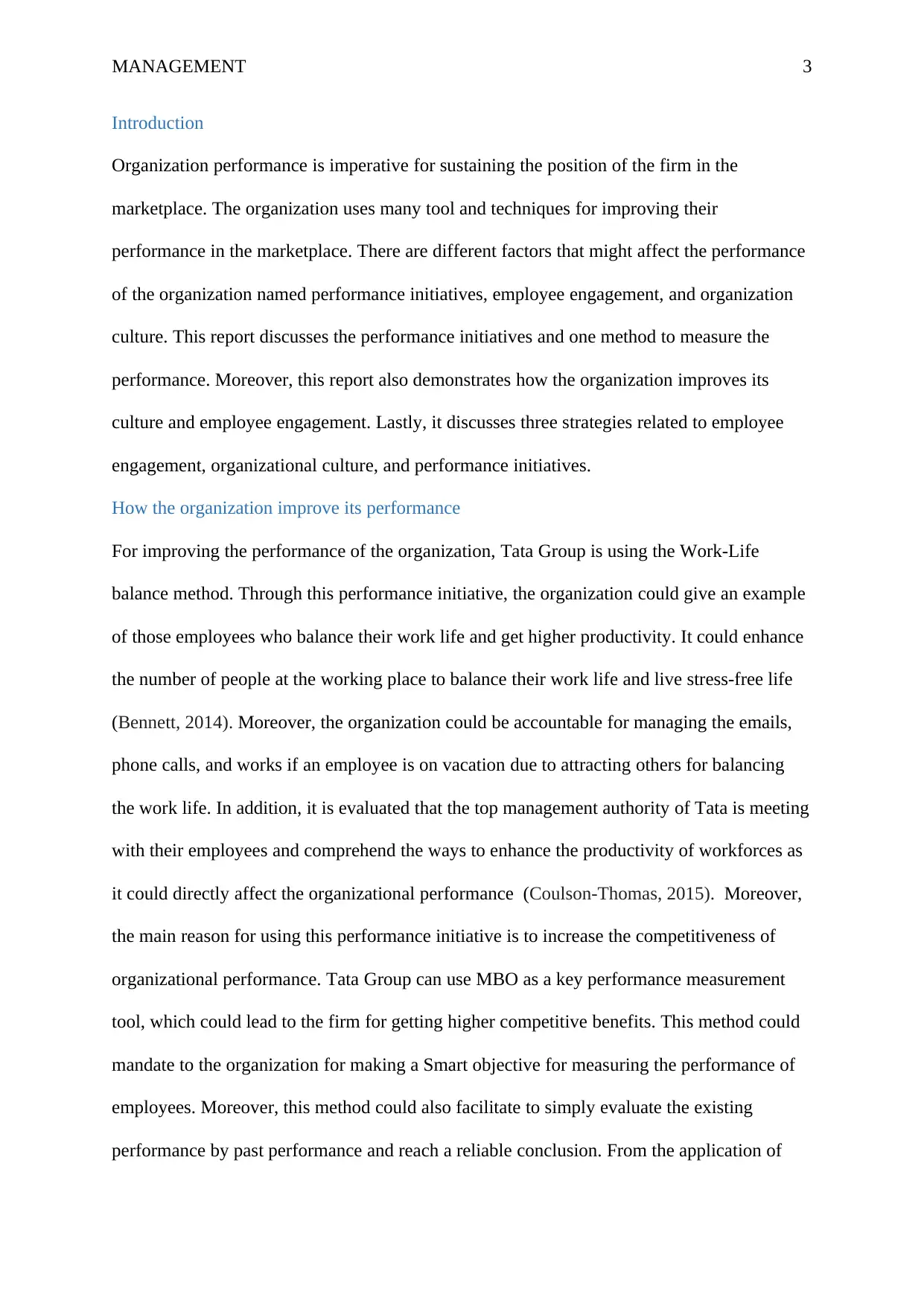
MANAGEMENT 3
Introduction
Organization performance is imperative for sustaining the position of the firm in the
marketplace. The organization uses many tool and techniques for improving their
performance in the marketplace. There are different factors that might affect the performance
of the organization named performance initiatives, employee engagement, and organization
culture. This report discusses the performance initiatives and one method to measure the
performance. Moreover, this report also demonstrates how the organization improves its
culture and employee engagement. Lastly, it discusses three strategies related to employee
engagement, organizational culture, and performance initiatives.
How the organization improve its performance
For improving the performance of the organization, Tata Group is using the Work-Life
balance method. Through this performance initiative, the organization could give an example
of those employees who balance their work life and get higher productivity. It could enhance
the number of people at the working place to balance their work life and live stress-free life
(Bennett, 2014). Moreover, the organization could be accountable for managing the emails,
phone calls, and works if an employee is on vacation due to attracting others for balancing
the work life. In addition, it is evaluated that the top management authority of Tata is meeting
with their employees and comprehend the ways to enhance the productivity of workforces as
it could directly affect the organizational performance (Coulson-Thomas, 2015). Moreover,
the main reason for using this performance initiative is to increase the competitiveness of
organizational performance. Tata Group can use MBO as a key performance measurement
tool, which could lead to the firm for getting higher competitive benefits. This method could
mandate to the organization for making a Smart objective for measuring the performance of
employees. Moreover, this method could also facilitate to simply evaluate the existing
performance by past performance and reach a reliable conclusion. From the application of
Introduction
Organization performance is imperative for sustaining the position of the firm in the
marketplace. The organization uses many tool and techniques for improving their
performance in the marketplace. There are different factors that might affect the performance
of the organization named performance initiatives, employee engagement, and organization
culture. This report discusses the performance initiatives and one method to measure the
performance. Moreover, this report also demonstrates how the organization improves its
culture and employee engagement. Lastly, it discusses three strategies related to employee
engagement, organizational culture, and performance initiatives.
How the organization improve its performance
For improving the performance of the organization, Tata Group is using the Work-Life
balance method. Through this performance initiative, the organization could give an example
of those employees who balance their work life and get higher productivity. It could enhance
the number of people at the working place to balance their work life and live stress-free life
(Bennett, 2014). Moreover, the organization could be accountable for managing the emails,
phone calls, and works if an employee is on vacation due to attracting others for balancing
the work life. In addition, it is evaluated that the top management authority of Tata is meeting
with their employees and comprehend the ways to enhance the productivity of workforces as
it could directly affect the organizational performance (Coulson-Thomas, 2015). Moreover,
the main reason for using this performance initiative is to increase the competitiveness of
organizational performance. Tata Group can use MBO as a key performance measurement
tool, which could lead to the firm for getting higher competitive benefits. This method could
mandate to the organization for making a Smart objective for measuring the performance of
employees. Moreover, this method could also facilitate to simply evaluate the existing
performance by past performance and reach a reliable conclusion. From the application of
⊘ This is a preview!⊘
Do you want full access?
Subscribe today to unlock all pages.

Trusted by 1+ million students worldwide
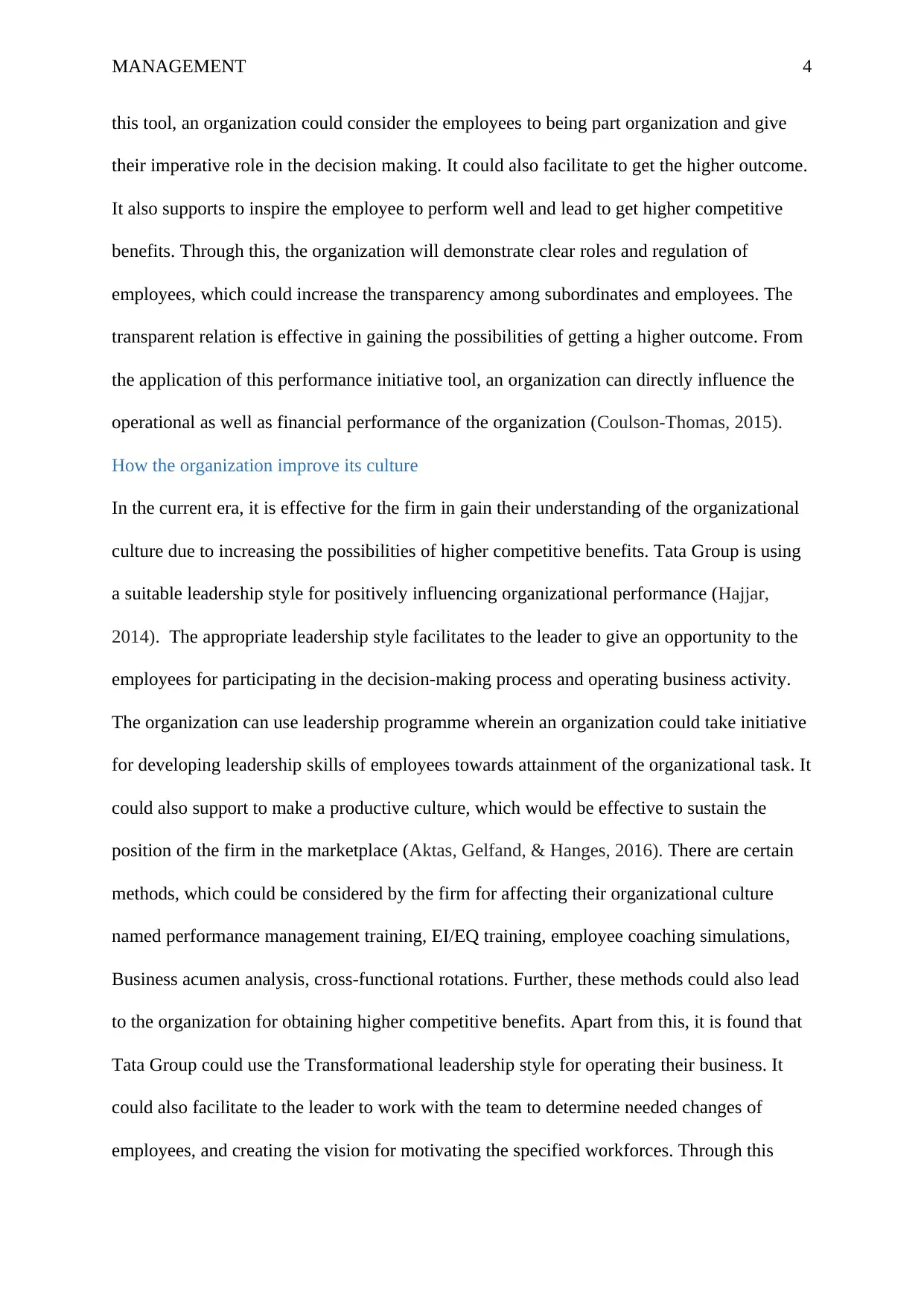
MANAGEMENT 4
this tool, an organization could consider the employees to being part organization and give
their imperative role in the decision making. It could also facilitate to get the higher outcome.
It also supports to inspire the employee to perform well and lead to get higher competitive
benefits. Through this, the organization will demonstrate clear roles and regulation of
employees, which could increase the transparency among subordinates and employees. The
transparent relation is effective in gaining the possibilities of getting a higher outcome. From
the application of this performance initiative tool, an organization can directly influence the
operational as well as financial performance of the organization (Coulson-Thomas, 2015).
How the organization improve its culture
In the current era, it is effective for the firm in gain their understanding of the organizational
culture due to increasing the possibilities of higher competitive benefits. Tata Group is using
a suitable leadership style for positively influencing organizational performance (Hajjar,
2014). The appropriate leadership style facilitates to the leader to give an opportunity to the
employees for participating in the decision-making process and operating business activity.
The organization can use leadership programme wherein an organization could take initiative
for developing leadership skills of employees towards attainment of the organizational task. It
could also support to make a productive culture, which would be effective to sustain the
position of the firm in the marketplace (Aktas, Gelfand, & Hanges, 2016). There are certain
methods, which could be considered by the firm for affecting their organizational culture
named performance management training, EI/EQ training, employee coaching simulations,
Business acumen analysis, cross-functional rotations. Further, these methods could also lead
to the organization for obtaining higher competitive benefits. Apart from this, it is found that
Tata Group could use the Transformational leadership style for operating their business. It
could also facilitate to the leader to work with the team to determine needed changes of
employees, and creating the vision for motivating the specified workforces. Through this
this tool, an organization could consider the employees to being part organization and give
their imperative role in the decision making. It could also facilitate to get the higher outcome.
It also supports to inspire the employee to perform well and lead to get higher competitive
benefits. Through this, the organization will demonstrate clear roles and regulation of
employees, which could increase the transparency among subordinates and employees. The
transparent relation is effective in gaining the possibilities of getting a higher outcome. From
the application of this performance initiative tool, an organization can directly influence the
operational as well as financial performance of the organization (Coulson-Thomas, 2015).
How the organization improve its culture
In the current era, it is effective for the firm in gain their understanding of the organizational
culture due to increasing the possibilities of higher competitive benefits. Tata Group is using
a suitable leadership style for positively influencing organizational performance (Hajjar,
2014). The appropriate leadership style facilitates to the leader to give an opportunity to the
employees for participating in the decision-making process and operating business activity.
The organization can use leadership programme wherein an organization could take initiative
for developing leadership skills of employees towards attainment of the organizational task. It
could also support to make a productive culture, which would be effective to sustain the
position of the firm in the marketplace (Aktas, Gelfand, & Hanges, 2016). There are certain
methods, which could be considered by the firm for affecting their organizational culture
named performance management training, EI/EQ training, employee coaching simulations,
Business acumen analysis, cross-functional rotations. Further, these methods could also lead
to the organization for obtaining higher competitive benefits. Apart from this, it is found that
Tata Group could use the Transformational leadership style for operating their business. It
could also facilitate to the leader to work with the team to determine needed changes of
employees, and creating the vision for motivating the specified workforces. Through this
Paraphrase This Document
Need a fresh take? Get an instant paraphrase of this document with our AI Paraphraser
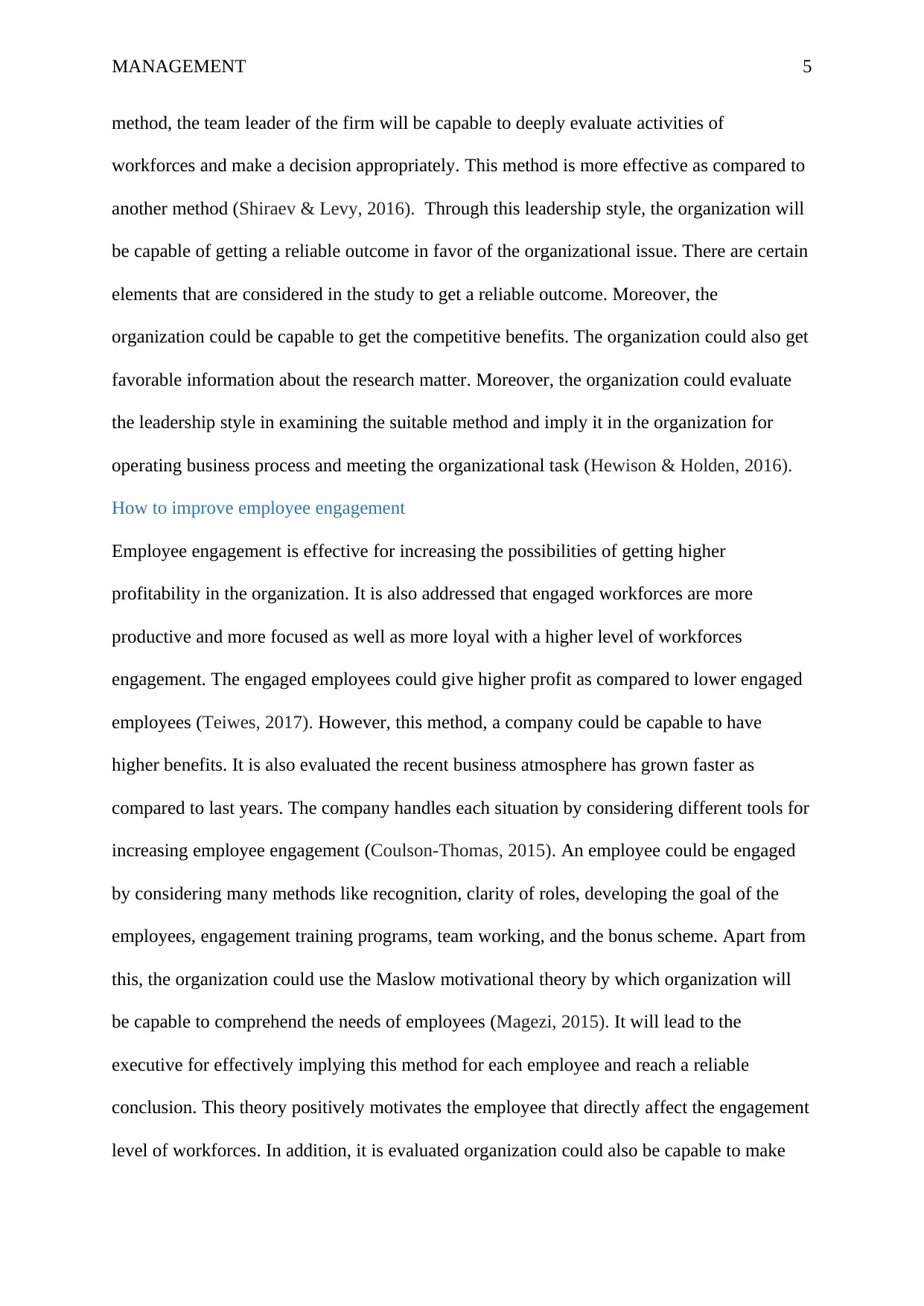
MANAGEMENT 5
method, the team leader of the firm will be capable to deeply evaluate activities of
workforces and make a decision appropriately. This method is more effective as compared to
another method (Shiraev & Levy, 2016). Through this leadership style, the organization will
be capable of getting a reliable outcome in favor of the organizational issue. There are certain
elements that are considered in the study to get a reliable outcome. Moreover, the
organization could be capable to get the competitive benefits. The organization could also get
favorable information about the research matter. Moreover, the organization could evaluate
the leadership style in examining the suitable method and imply it in the organization for
operating business process and meeting the organizational task (Hewison & Holden, 2016).
How to improve employee engagement
Employee engagement is effective for increasing the possibilities of getting higher
profitability in the organization. It is also addressed that engaged workforces are more
productive and more focused as well as more loyal with a higher level of workforces
engagement. The engaged employees could give higher profit as compared to lower engaged
employees (Teiwes, 2017). However, this method, a company could be capable to have
higher benefits. It is also evaluated the recent business atmosphere has grown faster as
compared to last years. The company handles each situation by considering different tools for
increasing employee engagement (Coulson-Thomas, 2015). An employee could be engaged
by considering many methods like recognition, clarity of roles, developing the goal of the
employees, engagement training programs, team working, and the bonus scheme. Apart from
this, the organization could use the Maslow motivational theory by which organization will
be capable to comprehend the needs of employees (Magezi, 2015). It will lead to the
executive for effectively implying this method for each employee and reach a reliable
conclusion. This theory positively motivates the employee that directly affect the engagement
level of workforces. In addition, it is evaluated organization could also be capable to make
method, the team leader of the firm will be capable to deeply evaluate activities of
workforces and make a decision appropriately. This method is more effective as compared to
another method (Shiraev & Levy, 2016). Through this leadership style, the organization will
be capable of getting a reliable outcome in favor of the organizational issue. There are certain
elements that are considered in the study to get a reliable outcome. Moreover, the
organization could be capable to get the competitive benefits. The organization could also get
favorable information about the research matter. Moreover, the organization could evaluate
the leadership style in examining the suitable method and imply it in the organization for
operating business process and meeting the organizational task (Hewison & Holden, 2016).
How to improve employee engagement
Employee engagement is effective for increasing the possibilities of getting higher
profitability in the organization. It is also addressed that engaged workforces are more
productive and more focused as well as more loyal with a higher level of workforces
engagement. The engaged employees could give higher profit as compared to lower engaged
employees (Teiwes, 2017). However, this method, a company could be capable to have
higher benefits. It is also evaluated the recent business atmosphere has grown faster as
compared to last years. The company handles each situation by considering different tools for
increasing employee engagement (Coulson-Thomas, 2015). An employee could be engaged
by considering many methods like recognition, clarity of roles, developing the goal of the
employees, engagement training programs, team working, and the bonus scheme. Apart from
this, the organization could use the Maslow motivational theory by which organization will
be capable to comprehend the needs of employees (Magezi, 2015). It will lead to the
executive for effectively implying this method for each employee and reach a reliable
conclusion. This theory positively motivates the employee that directly affect the engagement
level of workforces. In addition, it is evaluated organization could also be capable to make
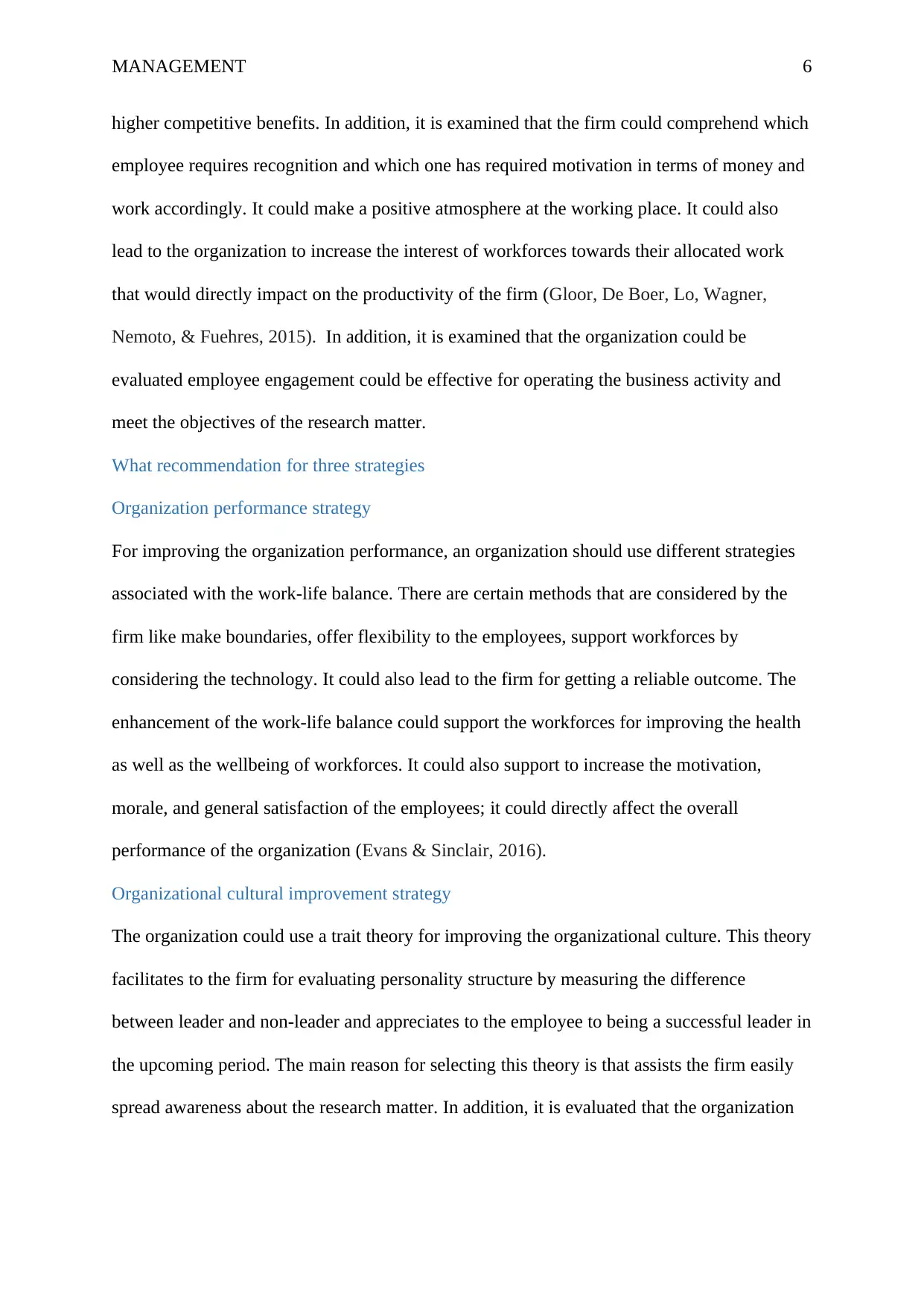
MANAGEMENT 6
higher competitive benefits. In addition, it is examined that the firm could comprehend which
employee requires recognition and which one has required motivation in terms of money and
work accordingly. It could make a positive atmosphere at the working place. It could also
lead to the organization to increase the interest of workforces towards their allocated work
that would directly impact on the productivity of the firm (Gloor, De Boer, Lo, Wagner,
Nemoto, & Fuehres, 2015). In addition, it is examined that the organization could be
evaluated employee engagement could be effective for operating the business activity and
meet the objectives of the research matter.
What recommendation for three strategies
Organization performance strategy
For improving the organization performance, an organization should use different strategies
associated with the work-life balance. There are certain methods that are considered by the
firm like make boundaries, offer flexibility to the employees, support workforces by
considering the technology. It could also lead to the firm for getting a reliable outcome. The
enhancement of the work-life balance could support the workforces for improving the health
as well as the wellbeing of workforces. It could also support to increase the motivation,
morale, and general satisfaction of the employees; it could directly affect the overall
performance of the organization (Evans & Sinclair, 2016).
Organizational cultural improvement strategy
The organization could use a trait theory for improving the organizational culture. This theory
facilitates to the firm for evaluating personality structure by measuring the difference
between leader and non-leader and appreciates to the employee to being a successful leader in
the upcoming period. The main reason for selecting this theory is that assists the firm easily
spread awareness about the research matter. In addition, it is evaluated that the organization
higher competitive benefits. In addition, it is examined that the firm could comprehend which
employee requires recognition and which one has required motivation in terms of money and
work accordingly. It could make a positive atmosphere at the working place. It could also
lead to the organization to increase the interest of workforces towards their allocated work
that would directly impact on the productivity of the firm (Gloor, De Boer, Lo, Wagner,
Nemoto, & Fuehres, 2015). In addition, it is examined that the organization could be
evaluated employee engagement could be effective for operating the business activity and
meet the objectives of the research matter.
What recommendation for three strategies
Organization performance strategy
For improving the organization performance, an organization should use different strategies
associated with the work-life balance. There are certain methods that are considered by the
firm like make boundaries, offer flexibility to the employees, support workforces by
considering the technology. It could also lead to the firm for getting a reliable outcome. The
enhancement of the work-life balance could support the workforces for improving the health
as well as the wellbeing of workforces. It could also support to increase the motivation,
morale, and general satisfaction of the employees; it could directly affect the overall
performance of the organization (Evans & Sinclair, 2016).
Organizational cultural improvement strategy
The organization could use a trait theory for improving the organizational culture. This theory
facilitates to the firm for evaluating personality structure by measuring the difference
between leader and non-leader and appreciates to the employee to being a successful leader in
the upcoming period. The main reason for selecting this theory is that assists the firm easily
spread awareness about the research matter. In addition, it is evaluated that the organization
⊘ This is a preview!⊘
Do you want full access?
Subscribe today to unlock all pages.

Trusted by 1+ million students worldwide
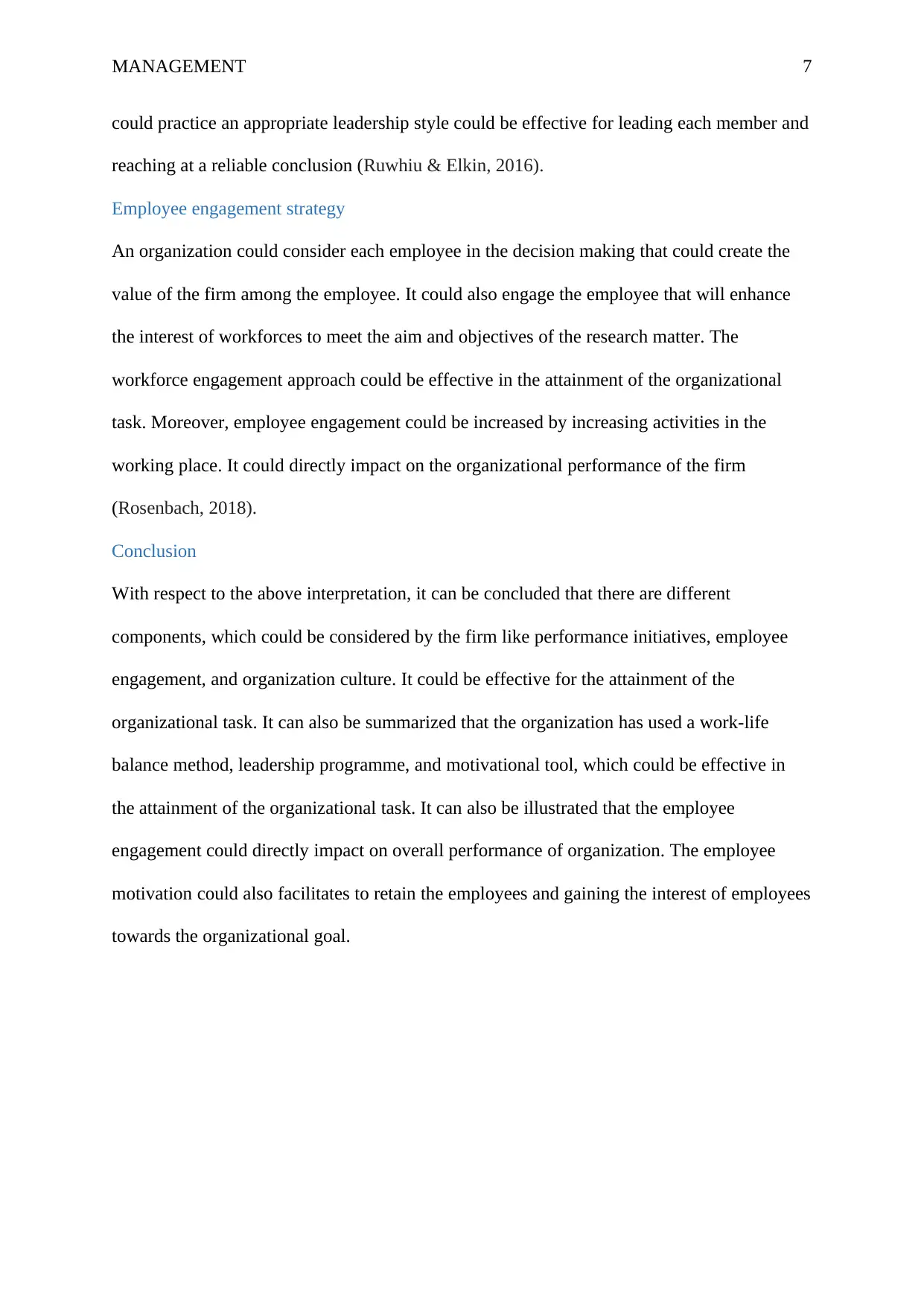
MANAGEMENT 7
could practice an appropriate leadership style could be effective for leading each member and
reaching at a reliable conclusion (Ruwhiu & Elkin, 2016).
Employee engagement strategy
An organization could consider each employee in the decision making that could create the
value of the firm among the employee. It could also engage the employee that will enhance
the interest of workforces to meet the aim and objectives of the research matter. The
workforce engagement approach could be effective in the attainment of the organizational
task. Moreover, employee engagement could be increased by increasing activities in the
working place. It could directly impact on the organizational performance of the firm
(Rosenbach, 2018).
Conclusion
With respect to the above interpretation, it can be concluded that there are different
components, which could be considered by the firm like performance initiatives, employee
engagement, and organization culture. It could be effective for the attainment of the
organizational task. It can also be summarized that the organization has used a work-life
balance method, leadership programme, and motivational tool, which could be effective in
the attainment of the organizational task. It can also be illustrated that the employee
engagement could directly impact on overall performance of organization. The employee
motivation could also facilitates to retain the employees and gaining the interest of employees
towards the organizational goal.
could practice an appropriate leadership style could be effective for leading each member and
reaching at a reliable conclusion (Ruwhiu & Elkin, 2016).
Employee engagement strategy
An organization could consider each employee in the decision making that could create the
value of the firm among the employee. It could also engage the employee that will enhance
the interest of workforces to meet the aim and objectives of the research matter. The
workforce engagement approach could be effective in the attainment of the organizational
task. Moreover, employee engagement could be increased by increasing activities in the
working place. It could directly impact on the organizational performance of the firm
(Rosenbach, 2018).
Conclusion
With respect to the above interpretation, it can be concluded that there are different
components, which could be considered by the firm like performance initiatives, employee
engagement, and organization culture. It could be effective for the attainment of the
organizational task. It can also be summarized that the organization has used a work-life
balance method, leadership programme, and motivational tool, which could be effective in
the attainment of the organizational task. It can also be illustrated that the employee
engagement could directly impact on overall performance of organization. The employee
motivation could also facilitates to retain the employees and gaining the interest of employees
towards the organizational goal.
Paraphrase This Document
Need a fresh take? Get an instant paraphrase of this document with our AI Paraphraser
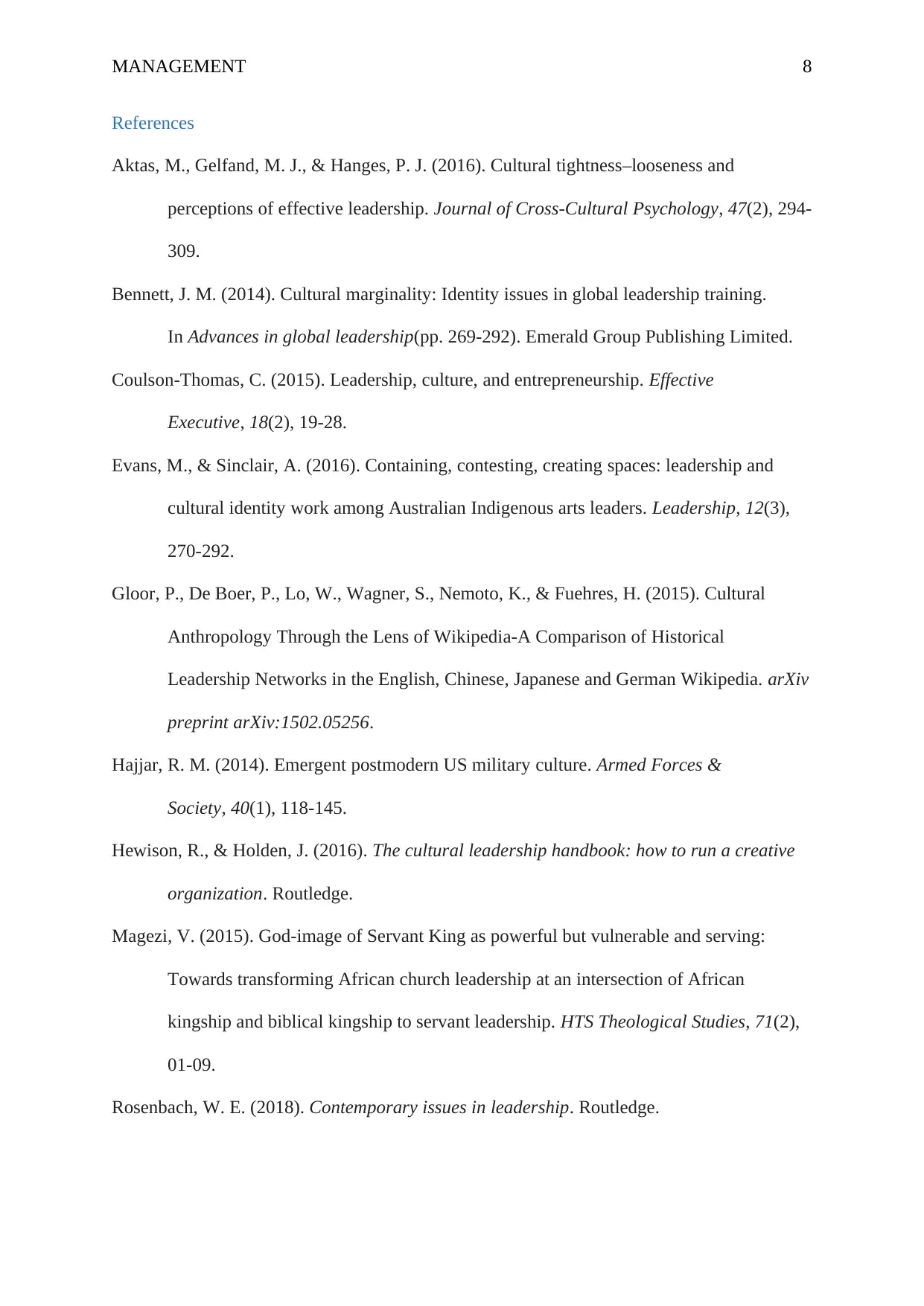
MANAGEMENT 8
References
Aktas, M., Gelfand, M. J., & Hanges, P. J. (2016). Cultural tightness–looseness and
perceptions of effective leadership. Journal of Cross-Cultural Psychology, 47(2), 294-
309.
Bennett, J. M. (2014). Cultural marginality: Identity issues in global leadership training.
In Advances in global leadership(pp. 269-292). Emerald Group Publishing Limited.
Coulson-Thomas, C. (2015). Leadership, culture, and entrepreneurship. Effective
Executive, 18(2), 19-28.
Evans, M., & Sinclair, A. (2016). Containing, contesting, creating spaces: leadership and
cultural identity work among Australian Indigenous arts leaders. Leadership, 12(3),
270-292.
Gloor, P., De Boer, P., Lo, W., Wagner, S., Nemoto, K., & Fuehres, H. (2015). Cultural
Anthropology Through the Lens of Wikipedia-A Comparison of Historical
Leadership Networks in the English, Chinese, Japanese and German Wikipedia. arXiv
preprint arXiv:1502.05256.
Hajjar, R. M. (2014). Emergent postmodern US military culture. Armed Forces &
Society, 40(1), 118-145.
Hewison, R., & Holden, J. (2016). The cultural leadership handbook: how to run a creative
organization. Routledge.
Magezi, V. (2015). God-image of Servant King as powerful but vulnerable and serving:
Towards transforming African church leadership at an intersection of African
kingship and biblical kingship to servant leadership. HTS Theological Studies, 71(2),
01-09.
Rosenbach, W. E. (2018). Contemporary issues in leadership. Routledge.
References
Aktas, M., Gelfand, M. J., & Hanges, P. J. (2016). Cultural tightness–looseness and
perceptions of effective leadership. Journal of Cross-Cultural Psychology, 47(2), 294-
309.
Bennett, J. M. (2014). Cultural marginality: Identity issues in global leadership training.
In Advances in global leadership(pp. 269-292). Emerald Group Publishing Limited.
Coulson-Thomas, C. (2015). Leadership, culture, and entrepreneurship. Effective
Executive, 18(2), 19-28.
Evans, M., & Sinclair, A. (2016). Containing, contesting, creating spaces: leadership and
cultural identity work among Australian Indigenous arts leaders. Leadership, 12(3),
270-292.
Gloor, P., De Boer, P., Lo, W., Wagner, S., Nemoto, K., & Fuehres, H. (2015). Cultural
Anthropology Through the Lens of Wikipedia-A Comparison of Historical
Leadership Networks in the English, Chinese, Japanese and German Wikipedia. arXiv
preprint arXiv:1502.05256.
Hajjar, R. M. (2014). Emergent postmodern US military culture. Armed Forces &
Society, 40(1), 118-145.
Hewison, R., & Holden, J. (2016). The cultural leadership handbook: how to run a creative
organization. Routledge.
Magezi, V. (2015). God-image of Servant King as powerful but vulnerable and serving:
Towards transforming African church leadership at an intersection of African
kingship and biblical kingship to servant leadership. HTS Theological Studies, 71(2),
01-09.
Rosenbach, W. E. (2018). Contemporary issues in leadership. Routledge.
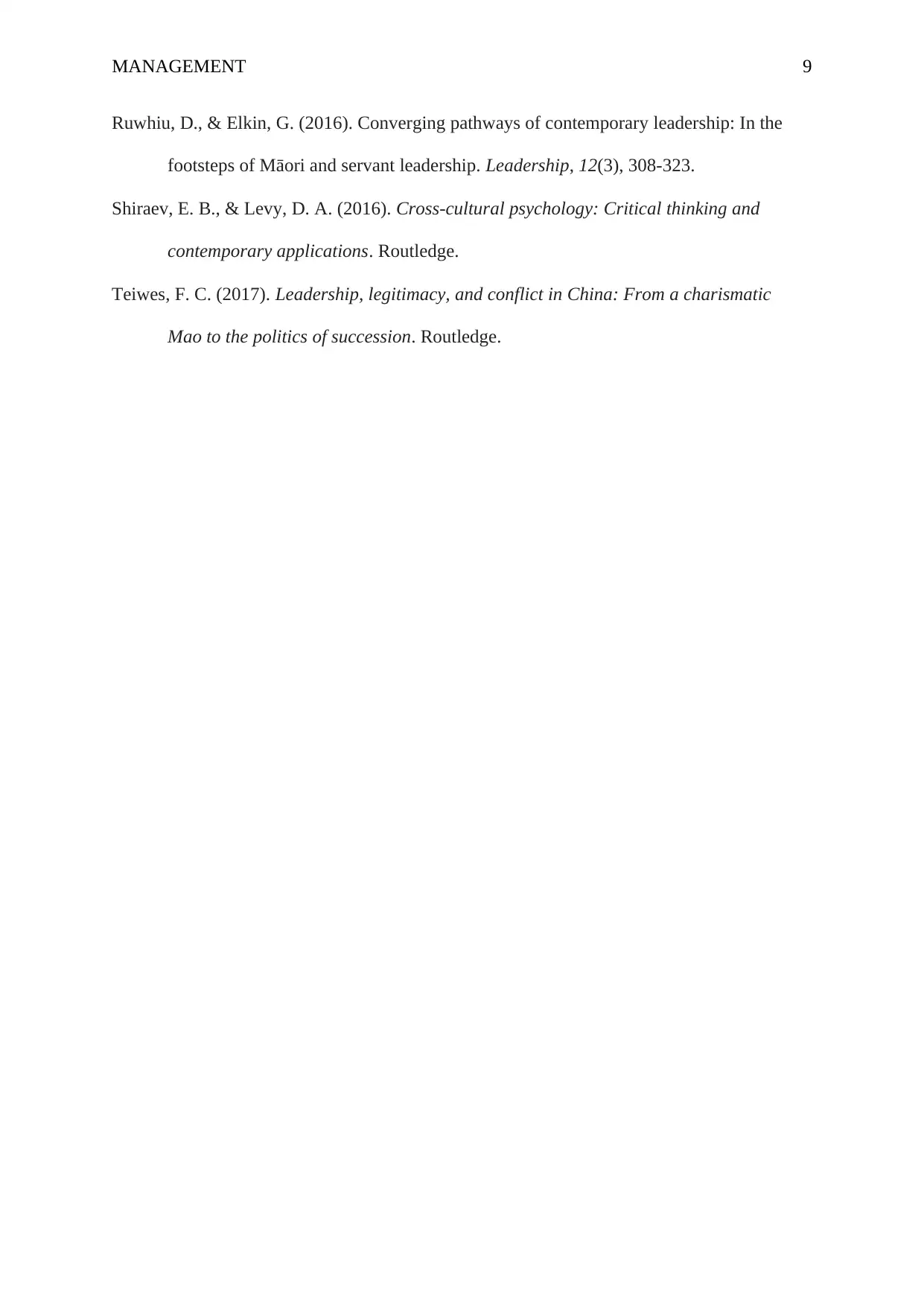
MANAGEMENT 9
Ruwhiu, D., & Elkin, G. (2016). Converging pathways of contemporary leadership: In the
footsteps of Māori and servant leadership. Leadership, 12(3), 308-323.
Shiraev, E. B., & Levy, D. A. (2016). Cross-cultural psychology: Critical thinking and
contemporary applications. Routledge.
Teiwes, F. C. (2017). Leadership, legitimacy, and conflict in China: From a charismatic
Mao to the politics of succession. Routledge.
Ruwhiu, D., & Elkin, G. (2016). Converging pathways of contemporary leadership: In the
footsteps of Māori and servant leadership. Leadership, 12(3), 308-323.
Shiraev, E. B., & Levy, D. A. (2016). Cross-cultural psychology: Critical thinking and
contemporary applications. Routledge.
Teiwes, F. C. (2017). Leadership, legitimacy, and conflict in China: From a charismatic
Mao to the politics of succession. Routledge.
⊘ This is a preview!⊘
Do you want full access?
Subscribe today to unlock all pages.

Trusted by 1+ million students worldwide
1 out of 9
Related Documents
Your All-in-One AI-Powered Toolkit for Academic Success.
+13062052269
info@desklib.com
Available 24*7 on WhatsApp / Email
![[object Object]](/_next/static/media/star-bottom.7253800d.svg)
Unlock your academic potential
Copyright © 2020–2025 A2Z Services. All Rights Reserved. Developed and managed by ZUCOL.





